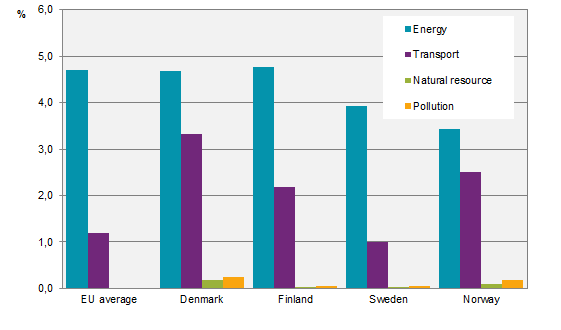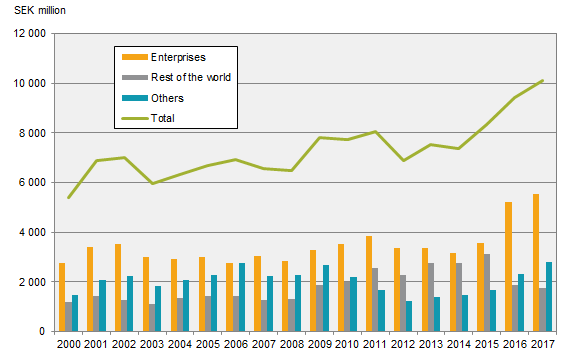Environmentally motivated subsidies and preliminary environmental tax revenue 2017:
Environmental tax revenues continued to increase
Statistical news from Statistics Sweden 2018-05-17 9.30
Environmental tax revenue in Sweden was SEK 98.6 billion in 2017, up by SEK 0.6 billion from 2016. The increase is lower than in 2014 and 2015, when revenue grew by SEK 11 billion in total. In 2017, environmentally motivated subsidies amounted to SEK 10.1 billion, the highest level since the beginning of the times series in 2000 and an increase of about 7 percent compared with 2016.
In 2017, SEK 98.6 billion was generated in environmental taxes. This is a small increase, SEK 0.6 billion, from 2016. In the two previous years, 2015 and 2016, environmental tax revenue grew by SEK 6.1 billion and SEK 5.1 billion respectively, driven up mostly by energy taxes and vehicle tax.
In 2017, revenue from energy tax on electricity increased by SEK 1.9 billion following an increase in the tax rate. At the same time, revenue from tax on the thermal effect of nuclear energy decreased by SEK 1.7 billion, which is due to this tax being gradually phased out. Tax on carbon dioxide also generated lower revenue in 2017. The carbon dioxide tax has been the single largest environmental tax revenue for the Swedish State since 2003, but now, its revenue is slightly less than the energy tax on fuel, SEK 23.5 billion compared to SEK 23.6 billion.
A new environmental tax, on certain chemical substances in electronics, was introduced in 2017. The purpose of this tax is to reduce the amount of toxic flame retardants. It generated SEK 0.7 billion in revenue.
Higher share of environmental taxes in Norway
The share of environmental tax revenue out of total tax revenue is an indicator that is comparable among European countries. Eurostat collects these statistics yearly and the most recent statistics are from 2016.
Today is 17 May, the Norwegian Constitution Day, and a comparison with Sweden’s neighbouring country shows that Norway has a higher share of environmental taxes than Sweden. Environmental taxes account for 5.0 percent of all tax revenue in Sweden, while in Norway, the corresponding figure is 6.2 percent. Furthermore, the trends in the two countries are divergent. In Norway, the share of environmental tax revenue has increased in recent years, while in Sweden it has declined since 2009. In addition, per capita environmental tax revenue in 2016 was higher in Norway than in Sweden, about EUR 1500 compared to EUR 1000.
Four different groups of environmental taxes – energy, transport, pollution and natural resources – can be examined in more detail. A comparison between the Nordic countries and an EU average is shown in the figure below. Energy taxes comprise the largest part of environmental tax revenue in the EU, on average 4.7 percent of all tax revenue. Only Finland’s figure is slightly higher, 4.8 percent, among the Nordic countries. The share of energy taxes is slightly higher in Sweden than in Norway, although it is lower than in the other Nordic countries.

Environmentally motivated subsidies
In 2017, environmentally motivated subsidies amounted to SEK 10.1 billion. This is the highest level since the beginning of the times series and an increase of about 7 percent compared with 2016. Environmentally motivated subsidies include transactions that help reduce climate and environmental impact and improve natural resources management. Subsidies are increasing in several areas. In the agricultural sector, subsidies are increasing following the introduction of “greening” in 2015. National support to climate initiatives, such as premiums for green vehicles, is increasing, and energy research initiatives are also growing.
These subsidies, that is, Government contributions for investments and consumption, are allocated to different actors, both nationally and internationally. Subsidies to enterprises, non-profit organisations and other government agencies have increased substantially since 2016 and account for 83 percent of total subsidies. The subsidies have been mostly designated for environmentally related improvements in agriculture and energy, and environmentally related research, for which Swedish enterprises have received support. Subsidies to the rest of the world, in the form of aid and international cooperation on the environment and climate, have decreased from SEK 1.8 billion in 2016 to SEK 1.7 billion in 2017.

Definitions and explanations
Environmental taxes
The definition of an environmental tax that is used by Statistics Sweden has been developed by Eurostat and the OECD. It is currently part of the global SEEA Central Framework statistical standards and makes comparative studies between different nations possible. The definition is:
"...it has been chosen to single out the tax base that seems to have a particular environmental relevance, and to consider all taxes levied on these tax bases as environmentally related regardless of motives behind their introduction, their names etc."
Consequently, according to the definition, it is the tax base that decides if a tax is environmental or not.
Statistics Sweden has presented statistics on environmental taxes since 1993.
Environmentally motivated subsidies
Environmentally motivated subsidies are defined according to the SEEA Central Framework statistical standards for environmental accounts. The definition that is used in the environmental accounts in Sweden is based on the motive behind the subsidy. Therefore the definition used in the environmental accounts is broader than the one used in the national accounts, i.e. the environmental accounts also include capital and current transfers and social benefits in kind.
To find the motive behind the subsidy, the primary source of information for the environmental accounts is the government’s budget propositions for different years. The statistics are derived from the National Financial Management Authority's calculations of the central government budget’s results where transactions are traced to the government appropriations from which they come. In 2015, Statistics Sweden carried out a development project that reviewed the methodology for the statistics
Statistics Sweden has presented statistics on environmentally motivated subsidies since 2000.
European statistics
European statistics can be found at Eurostat.
Statistical Database
More information is available in the Statistical Database
Feel free to use the facts from this statistical news but remember to state Source: Statistics Sweden.
